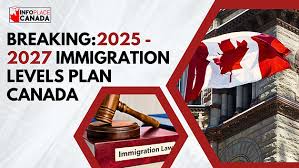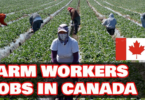Canada stands out as one of the most sought-after destinations for immigrants worldwide, owing to its inclusive immigration policies, stable economy, and exceptional quality of life. The country’s commitment to diversity and multiculturalism has made it an attractive choice for individuals and families seeking better opportunities and a higher standard of living.
Recognized Routes For Foreigners To Migrate To Canada 2025
To support economic growth and address workforce shortages, Canada actively welcomes skilled professionals, international students, and entrepreneurs. Various immigration pathways, such as Express Entry, Provincial Nominee Programs (PNPs), and work permits, have been designed to streamline the process for those who wish to contribute to the country’s economy. These programs not only help fill critical labor gaps but also provide immigrants with opportunities to establish themselves and build successful careers.
With an aging population and a growing need for specialized skills, Canada has placed significant emphasis on attracting talent in key sectors such as healthcare, technology, and construction. The demand for healthcare workers, including nurses and doctors, has increased due to an aging demographic requiring more medical care. Meanwhile, the technology industry continues to expand rapidly, driving the need for software developers, engineers, and IT professionals. The construction sector also requires a steady influx of skilled labor to support the country’s infrastructure projects and housing demands.
To maintain its competitive edge and sustain economic development, Canada consistently enhances its immigration policies and programs. It regularly updates its selection criteria, introduces new pilot programs, and offers permanent residency pathways to encourage immigrants to settle long-term. These initiatives reflect Canada’s long-term vision of leveraging immigration as a key driver of innovation, economic prosperity, and cultural diversity.
Best Routes for Foreigners to Move to Canada in 2025
The process of immigrating to Canada depends on factors such as work experience, education, language proficiency, and long-term career prospects. Some of the most recognized pathways include:
Express Entry: A competitive immigration system tailored for skilled professionals in fields like IT, healthcare, and engineering. This system ranks candidates based on the Comprehensive Ranking System (CRS) score, making it one of the fastest ways to secure permanent residency.
Provincial Nominee Program (PNP): Each Canadian province has specific labor market needs. If your skills align with regional demands, you can receive a nomination, fast-tracking your pathway to permanent residency.
Study Permits & Post-Graduation Work Permits (PGWP): International students can leverage Canadian education to transition into the workforce and apply for permanent residency under programs like the Canadian Experience Class (CEC).
Start-Up Visa & Business Immigration: Entrepreneurs and investors can explore business-oriented programs that lead to permanent residency, especially for those who can contribute to economic development.
Why Choose Canada?
Before diving into immigration pathways, it’s essential to understand why Canada is a top choice for immigrants. Here are some of the biggest reasons why people from around the world choose to move to Canada:
1. Strong Economy & Job Market
Canada has one of the world’s most stable economies, with low unemployment rates and a high demand for skilled professionals. Key industries that require foreign workers include:
- Technology & IT (Software Development, Data Science, AI, Cybersecurity)
- Healthcare (Doctors, Nurses, Pharmacists, Caregivers)
- Engineering (Mechanical, Civil, Electrical, Software Engineering)
- Skilled Trades (Construction, Plumbing, Welding, Electricians, Truck Drivers)
- Finance & Accounting (Banking, Investment, Auditing, Risk Analysis)
The country actively seeks skilled professionals to fill labor shortages and strengthen its economy, making it an excellent destination for career growth.
2. High Quality of Life
Canada consistently ranks among the top countries for quality of life due to:
- Universal Healthcare (Free medical services for permanent residents and citizens)
- World-Class Education System (Top-ranking universities and schools)
- Safe and Stable Environment (Low crime rates and political stability)
- Multicultural Society (Welcoming people from different backgrounds)
3. Immigration-Friendly Policies
Unlike many other countries with strict immigration rules, Canada has programs designed to attract and retain immigrants. The government has set ambitious targets to welcome over 500,000 new permanent residents annually through different pathways.
4. Pathway to Citizenship
Once you become a permanent resident, you can apply for Canadian citizenship after three years of residency. Citizenship has many benefits, including a Canadian passport and the ability to vote in elections.
Understanding the Immigration Process to Canada: Key Factors and Pathways
Immigrating to Canada is a life-changing decision that requires careful planning, preparation, and an understanding of the different pathways available. The process varies depending on several factors, including an individual’s work experience, educational background, language proficiency, and long-term career prospects. Each immigration route is designed to cater to specific needs, ensuring that applicants contribute meaningfully to Canada’s economy and society.
Key Factors That Influence Canadian Immigration Success
-
Work Experience:
Skilled professionals with experience in high-demand industries such as healthcare, technology, finance, and engineering have a greater chance of securing permanent residency. Work experience plays a crucial role in eligibility for programs like Express Entry, the Provincial Nominee Program (PNP), and employer-driven streams. -
Education:
Higher levels of education increase eligibility for immigration programs, especially those that prioritize skilled professionals. International students studying in Canada also have unique opportunities to transition from temporary residence to permanent residency through programs like the Post-Graduation Work Permit (PGWP) and the Canadian Experience Class (CEC). -
Language Proficiency:
Proficiency in either English or French is a crucial factor in the immigration process. Most programs require applicants to take standardized language tests such as the IELTS (International English Language Testing System) or TEF (Test d’évaluation de français) to assess their ability to integrate into Canadian society and the workforce. Higher language scores significantly increase an applicant’s eligibility under programs like Express Entry. -
Long-Term Career Prospects:
Canada prioritizes immigrants who can fill labor shortages and contribute to economic growth. Individuals with skills and qualifications aligned with high-demand sectors have better prospects for employment and permanent residency approval. Sectors like IT, healthcare, engineering, construction, and skilled trades continue to see high worker demand.
Most Recognized Pathways for Immigration to Canada
Canada offers multiple pathways to immigration, each designed for different categories of applicants. The most recognized programs include:
Express Entry:
This is Canada’s fastest and most competitive immigration system for skilled workers. It includes three primary streams:
- Federal Skilled Worker Program (FSWP): For professionals with at least one year of skilled work experience.
- Federal Skilled Trades Program (FSTP): For individuals in trades such as plumbing, welding, and electrical work.
- Canadian Experience Class (CEC): For individuals with prior Canadian work experience.
Provincial Nominee Program (PNP):
This program allows individual provinces to nominate candidates who meet their regional labor market needs. Each province has different eligibility criteria, and those selected can fast-track their application for permanent residency.
Study Permits & Post-Graduation Work Permits (PGWP):
International students can study in Canada and, after graduation, apply for a Post-Graduation Work Permit (PGWP) to gain Canadian work experience. Many students transition to permanent residency through programs like the Canadian Experience Class.
Family Sponsorship:
Canadian citizens and permanent residents can sponsor close family members, including spouses, children, parents, and grandparents, to join them in Canada under the Family Sponsorship Program.
Start-Up Visa & Business Immigration:
Entrepreneurs and investors who can create jobs and contribute to economic growth can apply for the Start-Up Visa Program, which offers permanent residency to those who establish innovative businesses in Canada.
Temporary Foreign Worker Program (TFWP) & Atlantic Immigration Program (AIP):
- The Temporary Foreign Worker Program (TFWP) allows Canadian employers to hire foreign workers to fill labor shortages in industries such as agriculture, hospitality, and healthcare.
- The Atlantic Immigration Program (AIP) is designed for skilled workers and international graduates looking to settle in Canada’s Atlantic provinces (New Brunswick, Nova Scotia, Prince Edward Island, and Newfoundland and Labrador).
Step-by-Step Immigration Process to Canada
Immigrating to Canada requires a well-structured approach to ensure a smooth transition. The process varies depending on the program you apply for, but the general steps remain the same across most pathways. Below is a detailed breakdown of the step-by-step process for immigrating to Canada.
1. Determine Eligibility for Immigration Programs
The first step in the immigration process is to determine which program best suits your qualifications, work experience, and long-term goals. Canada offers multiple immigration pathways, including:
- Express Entry (For skilled workers in Federal Skilled Worker Program, Federal Skilled Trades Program, and Canadian Experience Class)
- Provincial Nominee Program (PNP) (For individuals nominated by Canadian provinces based on regional labor market needs)
- Family Sponsorship (For individuals sponsored by Canadian citizens or permanent residents)
- Study Permit and Post-Graduation Work Permit (PGWP) (For international students looking to transition to permanent residency)
- Business and Investor Programs (For entrepreneurs and investors who want to start or invest in businesses in Canada)
To determine eligibility, applicants must evaluate factors such as age, education, work experience, language proficiency, adaptability, and financial stability. The Canadian government provides an official online eligibility assessment tool where potential immigrants can check if they meet the criteria for their chosen program.
2. Gather Required Documents
Once you have identified the best immigration program, the next step is to gather all required documents. The exact documentation depends on the program, but the most common documents include:
Identity and Travel Documents
- Valid passport
- Birth certificate
- National identification card (if applicable)
Educational Credentials
- Degree or diploma certificates
- Transcripts from educational institutions
- Educational Credential Assessment (ECA) report (for foreign degrees)
Work Experience Proof
- Reference letters from employers
- Job offer letter (if applicable)
- Salary slips or tax documents as proof of employment history
Language Proficiency Test Results
- English: IELTS (International English Language Testing System) or CELPIP (Canadian English Language Proficiency Index Program)
- French: TEF (Test d’évaluation de français) or TCF (Test de connaissance du français)
Financial Documents
- Bank statements showing proof of sufficient settlement funds
- Property valuation reports (if applicable)
- Investment and asset records
Additional Supporting Documents
- Marriage certificate (if applying with a spouse)
- Police clearance certificate (criminal background check)
- Medical examination reports (to be completed after receiving an Invitation to Apply)
All documents must be clear, complete, and translated into English or French if originally issued in another language.
3. Submit an Online Profile (Express Entry, PNP, or Other Programs)
After gathering the required documents, applicants need to create and submit an online profile based on their chosen immigration pathway.
For Express Entry Applicants
Candidates must create an Express Entry profile on the Immigration, Refugees, and Citizenship Canada (IRCC) website. This profile includes personal details such as:
- Work experience
- Education
- Language test scores
- Family details
- Financial information
Each profile is assigned a Comprehensive Ranking System (CRS) score, which determines the likelihood of receiving an Invitation to Apply (ITA).
For Provincial Nominee Program (PNP) Applicants
Candidates applying through a Provincial Nominee Program must first apply to a specific province’s nominee program. If selected, they will receive a provincial nomination, which significantly boosts their CRS score in Express Entry.
For Family Sponsorship Applicants
Applicants being sponsored by family members must submit an application under the Family Sponsorship category, including proof of relationship and the financial ability of the sponsor.
For Business and Investor Program Applicants
Entrepreneurs and investors must submit a detailed business plan along with financial proof to qualify for investor immigration programs such as the Start-Up Visa Program.
Once the online profile is completed and submitted, applicants must wait for the next round of invitations from IRCC.
4. Receive an Invitation to Apply (ITA)
Applicants with the highest CRS scores in the Express Entry system receive an Invitation to Apply (ITA) during regular draws conducted by the Canadian government. ITAs are also issued under the Provincial Nominee Program and other pathways based on eligibility.
After receiving an ITA, applicants have 60 days to submit a complete permanent residency application with all required documents.
5. Submit a Complete Permanent Residency (PR) Application with Fees
Once an ITA is received, the applicant must fill out the PR application and pay the processing fees. The application must include:
- Personal information and background details
- Uploaded copies of all supporting documents (work experience proof, education credentials, etc.)
- Medical examination proof (to be completed before submission)
- Police clearance certificate (from all countries where the applicant has lived for six months or more in the past 10 years)
Application Fees (As of 2025, Subject to Change)
- Express Entry Application Fee: $1,365 CAD per adult
- Right of Permanent Residence Fee: $515 CAD per adult
- Dependent child fee: $230 CAD per child
Payment must be made online before submitting the final application.
6. Pass a Medical Exam & Security Clearance
Every applicant must undergo a medical examination conducted by an IRCC-approved physician. The exam includes:
- A general physical check-up
- Blood and urine tests
- X-rays (for tuberculosis screening)
In addition, applicants must submit a police clearance certificate from every country they have lived in for six months or more in the past decade. This ensures that applicants do not have a criminal record or pose a security risk to Canada.
Failure to pass these checks may result in a rejection of the application.
7. Receive a Confirmation of Permanent Residence (COPR)
If the application is approved, applicants receive a Confirmation of Permanent Residence (COPR) document along with a Canadian visa stamp in their passport.
The COPR includes important details such as:
- The applicant’s personal information
- The validity period for entering Canada
- Conditions of permanent residence
Applicants must ensure they enter Canada before their COPR expires.
8. Move to Canada and Apply for a Permanent Resident (PR) Card
Once in Canada, new permanent residents must complete the landing process by presenting their COPR and passport to an immigration officer at a Canadian port of entry.
After successful verification, they receive their Permanent Resident (PR) status, which allows them to:
- Live and work anywhere in Canada
- Access healthcare and social services
- Apply for Canadian citizenship after meeting residency requirements
New PR holders must apply for a Permanent Resident Card, which serves as official proof of their immigration status. The PR card is essential for traveling in and out of Canada.
Final Steps After Arriving in Canada:
- Obtain a Social Insurance Number (SIN) for employment
- Open a Canadian bank account
- Register for healthcare and social services
- Find accommodation and explore job opportunities
Conclusion
The Canadian immigration process requires careful planning, documentation, and adherence to government guidelines. By understanding each step in detail, applicants can increase their chances of success and make a smooth transition to life in Canada.
Whether you are a skilled worker, student, entrepreneur, or family member of a Canadian resident, following this step-by-step guide will help you navigate the application process and achieve your goal of becoming a permanent resident in Canada.







